Proprio is an Italian word that can have different meanings according to the context in which it’s used. So, let’s see how to use proprio in Italian without making mistakes. Proprio 1. The first meaning of proprio in Italian as an adverb is really. Examples: a. E’ proprio buono! a. It’s really good! b. Mi …
Grammar
Let’s learn seven common Italian pronominal verbs
Pronominal verbs in Italian are those verbs that change their meaning when combined with pronominal particles – ci, ne, la – or with reflexive pronouns. They are commonly used in Italian, that’s why at some point during your learning journey it’s important to learn them. So, today, I’d like to explain the meaning of seven …
What’s the difference between chi and che in Italian?
Chi e che sono due parole italiane comuni che hanno significati diversi e sono usati in modi diversi. Chi and che are two common Italian words that have different meanings and are used in different ways. Se hai appena iniziato a imparare l’italiano, all’inizio potresti confondere chi con che, o l’opposto. In realtà, è molto …
What’s the difference between chi and che in Italian?Read More
Farcela – What it means and how to use it
Farcela is a very common Italian pronominal verb. It’s a pronominal verb because it’s composed by the verb fare plus the pronouns ce + la. Farcela in italian can be used in different situations. So, let’s see when and how to use the verb farcela. Conjugation of Farcela The conjugation of this verb is pretty …
Difference between apocope and apostrophe in Italian
When you start learning Italian sooner or later you’ll come across words such as un’ape, quest’anno, sta’ a vedere, etc. What do they have in common? A symbol. This symbol ’. Now, looking at the examples above you might be thinking that this symbol ’ has always the same function. But it actually doesn’t. Indeed, …
Difference between apocope and apostrophe in ItalianRead More







